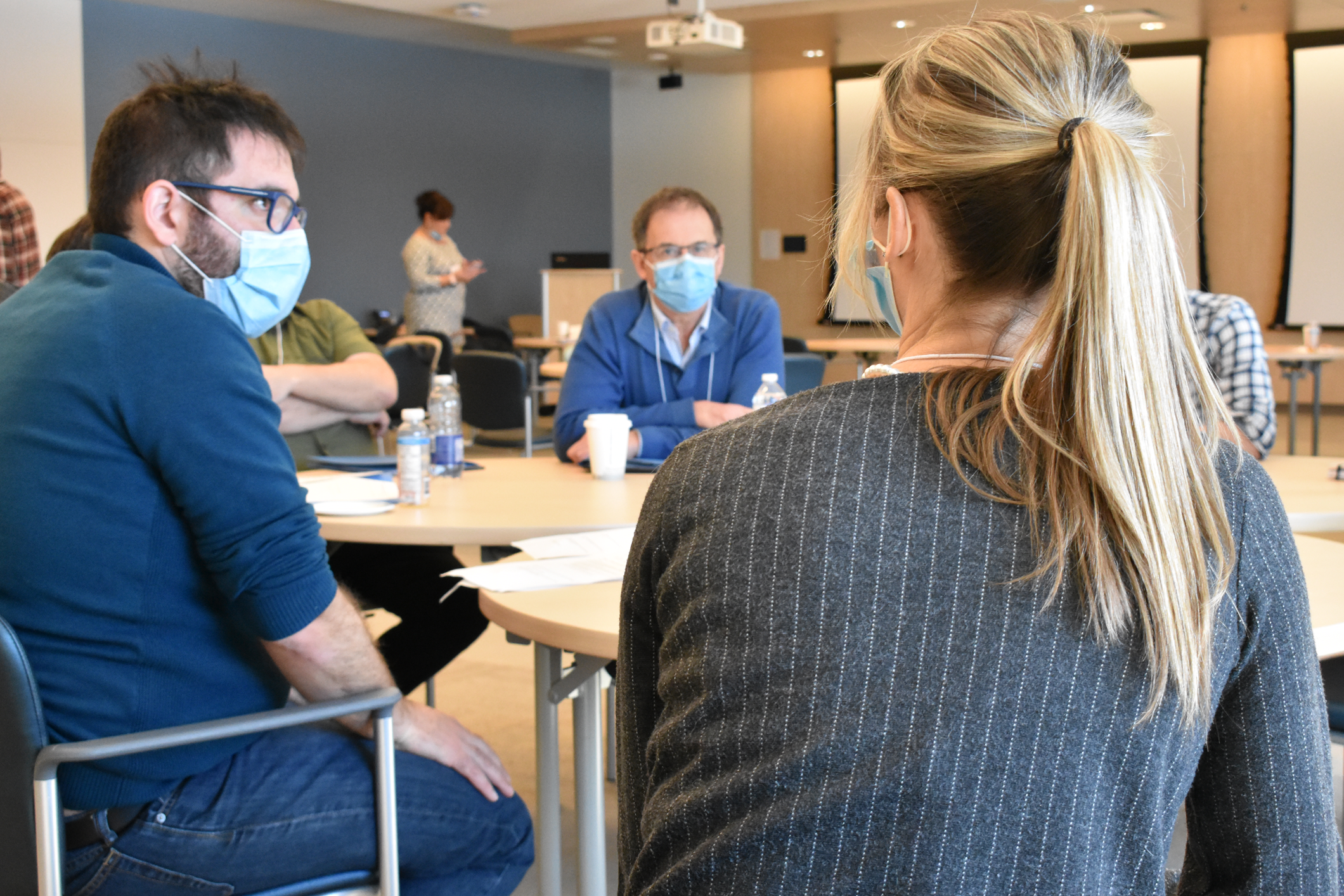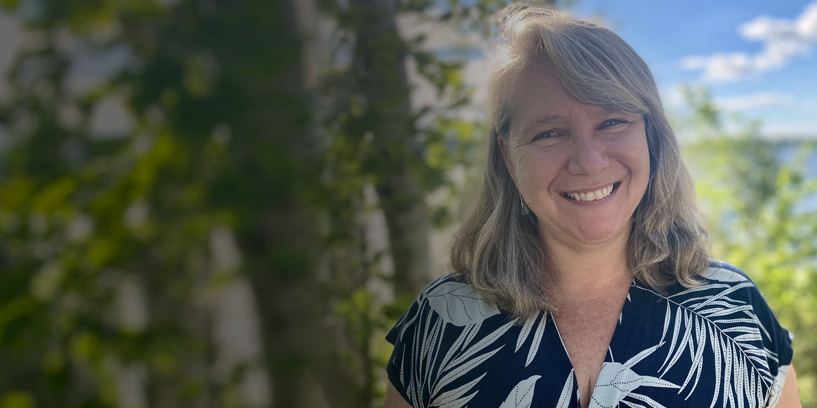A five-year plan (2023 – 2028) for
Achieving our best health
as people, as providers, as a system.
Ka gashkitoonaa mino bimaadiziwin
A message from our Executive Lead
Improving health and wellbeing for everyone in our communities. Anyone who has ever felt unsupported by public health care, community, and social services, or simply didn’t know where to turn when they needed help, will understand the need to have a home base from which care can be easily accessed. A place for everyone to have a supportive and fully-connected neighbourhood of health care, social and wellness services.
That is not the reality in today’s health-care system. In our region, as in regions across the country, emergency departments are overwhelmed, hospital beds are full, and people are not able to access the care they need when and how they need it. When service providers operate in isolation, they are limited in their abilities to affect people’s overall health and wellbeing. The ways in which health care is currently funded and operated, through organizational silos, makes collaboration and communication difficult.
This is why we’re working together to radically redesign the health-care system. Through innovative partnerships, the FLA OHT is changing how care is coordinated across health, social, and wellness services in our communities. During the COVID-19 pandemic, we have seen how working together has proven to be essential in ensuring the health of our workforces and making sure people get the care they need. Harnessing the power of partnership will expand our capacity, responsiveness, and ability to create a value-based system of health care and wellness, where value is defined as having accountability for achieving the best possible, evidence-based health-care quality, experiences and outcomes for everyone, everywhere in our communities.
By strengthening care in communities, building a foundation in primary care, relieving pressure on hospitals, and empowering people to better manage their own health and wellness, the FLA OHT is uniting partners with a common purpose to overcome challenges and seize opportunities to create stronger, more connected support systems and healthier communities.
Moving from vision to reality. Great ideas need an action plan. The following strategic plan was informed by engagement activities that took place throughout 2022 and involved FLA OHT partners and the general public including the Francophone and Indigenous communities. Over 1,000 people were engaged in various ways, including a survey, in-person and online discussion groups and sharing personal stories. Based on everything our community said was important about their health care, we created a draft plan and validated with community members and partners that we were on the right track. Input received through the strategic planning process has enabled the FLA OHT to set priorities and actions to address the health and wellness needs of our communities over the next five years.
We thank everyone for their contributions to this plan and ongoing commitment to Achieving our best health, together.
Our Strategic Directions
Learn more about our Strategic Directions
As the context and direction for all our actions, our strategic directions clearly align our efforts to ensure we fulfill our mission, vision and the outcomes we are aiming to achieve over the next five years. They ensure a focus on all domains of a high-performing health system, according to health care’s ‘Quintuple Aim’ of improving health equity, peoples’ care quality and experiences, population health and provider experience while delivering better health outcomes at less cost. Our strategic directions follow the framework of these five big aims. They also align with the spirit of value-based care where collaboration fosters better use of scarce resources, improves efficiency and delivers outcomes that matter to the people we serve while generating savings by ensuring people get the right care, in the right place, at the right time.
1. Promote equitable health and wellness
1.1 Deliver culturally and linguistically appropriate, accessible, trauma-informed care for everyone in our FLA OHT
Starting points:
- Listen and learn from equity-deserving populations to identify and address opportunities and barriers
- Create a health equity roadmap, standards and tools to help providers deliver the same level of care for all populations
- Implement income screening to ensure people with low incomes are identified and connected to supports
1.2 Build capacity to support the health and social needs of Indigenous and Francophone communities
Starting points:
- Ensure all providers have Indigenous Cultural Safety training and provide culturally safe spaces
- Implement language translation services in all health-care settings
- Create Health Home connections to the community Traditional Healing Coordinator
- Create navigation pathways for Francophone andIndigenous health services, providers andresources
1.3 Reduce barriers to health and wellness for vulnerable and marginalized populations
Starting points:
- Work with community partners addressing health equity issues (EG: Integrated Care Hub, Homelessness Collective Impact Committee, KCHC Mobile Health Home, Oasis Seniors Supportive Living, Rural Health Innovation Program, Compassionate Communities Kingston, KCHC Immigrant Services & others) to enhance andconnect services while co-designing an equitable, barrier-free health system that is available 24/7
2. Improve health-care quality
2.1 Ensure everyone has access to high quality, team-based care from a People-Centred Health Home throughout their life span
Starting points:
- Implement a Health Home Quality Framework built on best practices
- Create a new team-based clinic model with locations to serve people who do not have a primary care provider
- Implement My Practice reports in all Health Homes to support continuous quality improvement
2.2 Coordinate care in priority areas: aging-well-at home, palliative care, integrated addictions and mental health, coordinated discharge, access to primary care
Starting points:
- Create new roles to connect people with the care they need (EG: embedded care coordinators, care navigators, health & social care integrators, Aging-Well @ Home advocates, community support volunteers, prevention practitioners)
- Implement ‘Access MHA’ 24/7
- Expand shared care mental health rounds for all ages
- Create a health-care service navigation system
- Deliver high quality, equitable access to palliative care
2.3 Help people stay healthy and well in their homes and communities
Starting points:
- Embed Home Care and Community Support Services within Health Homes
- Proactively identify people who need home care and community-based supports earlier in their health-care journey
3. Empower people to achieve their best health and wellness
3.1 Promote health, prevent disease and address social determinants of health
Starting points:
- Encourage participation in cancer and other health screening programs
- Develop a health promotion outreach and transportation strategy to connect vulnerable and marginalized people with prevention, health, wellness & social services and supports
- Promote immunizations to prevent serious illnesses in our community
3.2 Empower people to self-manage their preventative care, health, wellness and chronic conditions
Starting points:
- Encourage active living, healthy eating, healthy aging and other health promoting behaviours
- Embed accessible self-management programs into all Health Homes
- Improve digital access to personal health information and educational resources
3.3 Support pandemic response and recovery
Starting points:
- Implement clinics and pathways that improve access and wait times for specialty care
- Bring specialized care out of hospital and into people’s Health Homes, homes and communities
- Implement strategies that improve access to prevention, wellness and social services
- Coordinate COVID vaccination opportunities
4. Support provider well-being
4.1 Create capacity for health and social care providers to provide the highest quality care
Starting points:
- Expand team-based care so all providers have the support and connections they need to provide the best possible care while supporting their own well-being
- Establish community support volunteer models that enhance provider capacity
4.2 Connect all FLA health and social service providers on one common health record
Starting points:
- Initiate primary care pilot of the Lumeo Health Information System to enhance quality, efficiency and service
- Seamlessly integrate digital health information systems across providers
- Embed best-practice guidelines for integrated care into digital health systems and tools
- Promote use of portable devices to support point of care documentation for all providers
4.3 Address regional Health Human Resource challenges
Starting points:
- Develop a collaborative regional health human resources plan
- Work with partners to recruit and retain health-care professionals including Francophone and Indigenous professionals
- Work with education partners to increase training spots for health-care professionals in all disciplines
- Create regional hubs of support for providers’ mental, physical, social, emotional, and spiritual well-being so that we have strong, resilient and capable professionals
5. Deliver value-based care
5.1. Create the space, mechanisms and models for providers to collaborate and integrate services to keep people healthy
Starting points:
- Work with Ontario Health to develop governance guidance for OHTs
- Conduct a formal assessment of our integrated care and governance models to build on our early successes, pin-point next steps in our integrated care journey and inform annual operating plans
- Work with partners to implement a mature, inclusive governance structure to help bring the Health Home model to life as the foundation of the health system
5.2 Work with partners to develop a sustainable, inclusive budget and resource model for FLA OHT
Starting points:
- Secure sustainable support for FLA OHT leadership and administrative supports
- Realign current funding allocations to support integrated, team-based, wrap-around care, services andsupports for the people we serve
5.3 Empower FLA OHT care networks to be full, active participants in co-designing the future health-care system.
Starting points:
- Solidify Terms of Reference for each care network
- Develop network action plans connected to the FLA OHT strategy and priority projects
- Increase opportunities to connect more partners to the FLA OHT
- Develop action plans to improve the offer of French language health services, Indigenous health services and services for other unique populations
Foundations for Success
Learn more about our Foundations for Success
Our foundations for success are the building blocks that the FLA OHT needs to put in place to ensure we fulfill our vision, mission, strategic directions and the outcomes we are aiming to achieve over the next five years.
1. Establish People-Centred Health Homes
1.1 Support all primary care groupings to become team-based, People-Centred Health Homes
Starting points:
- Co-design Health Home implementation standards, tools, education and a roadmap for delivery
- Promote training opportunities for Health Homes on Active Offer for French language services, Indigenous cultural safety, & trauma-informed care
1.2 Ensure all People-Centred Health Homes deliver core embedded services and connections to community-based, social and specialty health-care services
Starting points:
- Collaborate with FLA OHT partners to identify where each one fits within or as a connection to each Health Home
- Help all Health Homes provide a common basket of services and supports across peoples’ life span
- Develop Health Home connection mechanisms including one health record, pathways to health, wellness & social services, multidisciplinary rounds, referral systems andequity-oriented care models
1.3 Create equity-oriented health-care and population health management models to meet the unique needs of Indigenous, Francophone and equity-deserving populations.
Starting points:
- Provide training andtools to Health Homes on equity-oriented, trauma- and violence-informed care, linguistic andcultural safety and harm reduction
2. Cultivate a learning health system
2.1 Cultivate a learning health system that supports continuous quality improvement, education, professional development and builds health human resource capacity
Starting points:
- Create an FLA OHT learning and professional development plan
- Support all FLA OHT initiatives with Quality Improvement methods and tools
- Collaborate with and learn from other Ontario Health Teams
2.2 Collaborate with OHT research and evaluation partners to build and implement an OHT evaluation framework and support research initiatives
Starting points:
- Create logic models for all FLA OHT working groups
- Build an FLA OHT evaluation and strategy performance framework
- Participate in research initiatives that advance our strategic directions and goals
2.3 Apply a population health management approach to all initiatives
Starting points:
- Implement a data and decision support model for working groups and Health Homes
- Apply population segmentations, health status & system utilization data to each working group
3. Advance digital health
3.1 Create one health record that is shared across all people and providers in FLA OHT and is accessible from wherever they are
Starting points:
- Secure a primary care pilot of the Cerner electronic medical record system (Lumeo Project) with governance and support models
- Ensure linguistic preference is reflected in all digital health tools
- Explore digital health connections for home and community support services
3.2 Create a health and social service navigation strategy that supports seamless connections to information and supports for community members and providers
Starting points:
- Engage community members and providers to identify needs and explore navigation models
- Digitize the continuum of service navigation, electronic referral, appointment booking and access to patient health information
- Support Provincial work to create a Patient Portal that enables everyone to access and contribute to their own health information
3.3 Develop a privacy and data sharing framework to inform system planning and population health management
Starting points:
- Participate in the regional information sharing collaborative
- Participate in the PHIPA modernization consultations
- Support advancement of best privacy policies across all providers
4. Communicate, engage, co-design
4.1 Engage with patients, families and community members to co-design health and social care that meets their needs
Starting points:
- Evaluate and continuously improve our communications & community engagement framework
- Co-design strategic and annual plans, working group initiatives with community members
- Participate with Indigenous Health Council, Comite de Citoyens and other citizen groups
- Collaborate with neighbouring OHTs
4.2 Collaborate with committees tackling social issues in our community that affect people’s health
Starting points:
- Provide OHT representation for key community groups tackling social issues (EG: Homelessness Collective Impact Committee, Mental Health System Advisory Committee & others) to promote joint planning and action to address health and related social issues
- Foster cross-sector connections across community committees andFLA OHT projects
4.3 Sustain continuous communication across FLA OHT and the communities we serve
Starting points:
- Continue to grow FLA OHT communication and social media channels
- Work with community partners to leverage communication channels and keep our communities informed and engaged with our work
- Support public education that helps people make the best use of system resources
- Build a robust FLA OHT website that creates one integrated hub for information and access to collaboration and digital health tools
Five-year Outcomes
Our five-year outcomes are those that:
- we want to achieve as a result of pursuing our strategic directions and starting points for action over the next five years.
- are specific and measurable through either process, outcome or other types of specific quality and system-integration indicators.
- will form the basis for constructing a detailed Strategy Performance Dashboard with a series of indicators
- will help us track and communicate our progress along our journey to Achieving our best health.
Achieving our best health is a call to action to all health, social and wellness providers that things need to change and are changing. Together we are making progress now and are building on our work. At the end of five years, we will be able to say that:

1. Health Homes
Everyone in FLA has a People-Centred Health Home that provides team-based care, digital-health solutions, embedded mental-health supports, home care and community supports and 24/7 coordination & navigation services that reflects their cultural and linguistic preferences.

2. Improvements for all
Community members and providers report high satisfaction and better health outcomes with team-based care Health Homes.

3. Meaningful values
FLA OHT partners have built a governance structure that values collaboration, community participation and fosters shared accountability for outcomes that matter to the people we serve and the providers who serve them.

4. Data & systems support
People in our communities are healthier and we have the data, systems and structures to make continuous improvements.

5. Top performer
Our OHT is a top performer on measures of system integration.

Achieving our best health
as people, as providers, as a system.
Learn more about us!
Learn more about how we’re working with Indigenous partners.
We acknowledge and respect Indigenous concepts of health and wellbeing. We are working together to build a system that recognizes and offers Indigenous health practices for Indigenous People. We are committed to engaging with Indigenous Peoples and community members in a good way, using Indigenous teachings and tools in our work, incorporating the community’s suggestions and building stronger partnerships. We respect the Two Row Wampum, Dish with One Spoon and Indigenous Medicine Wheel concepts as we work together to create a health-care system that is inclusive and equal for all.
Learn more about how we’re working with Francophone partners.
We engage the Francophone community on a regular basis and include their experiences with the goal of removing linguistic barriers to care and building an accessible health and wellness system for all. Access to health services in French is a right that is recognized in the FLA OHT. Réseau des services de santé en français de l’Est de l’Ontario is an actively engaged partner. We have a strong partnership with Francophone community members through the Comité des Citoyens and consult regularly with members to hear from them directly. We respect and honour the City of Kingston’s French Language designation and offer bi-lingual services where we can as we work towards the active offer of French language services in all our Health Homes.
Learn about our Community Council
Community members include patients, clients, families, caregivers and citizens.
The voices of community members provide a crucial contribution to the success of the Frontenac, Lennox & Addington Ontario Health Team.
Learn about our priority projects and digital supports
Learn more about health system and population data for this region.
To help us build our strategy, we used key demographic and clinical information to allow us to better understand the people and the health and wellness needs in the region. Collecting and reviewing information about the people who make up our communities, hospital care, long term care and primary care data among other information has been and will continue to be extremely important in shaping our goals and strategies.
We would love to hear from you!
Follow us on Twitter @FLA_OHT and Facebook





